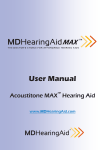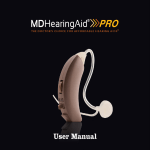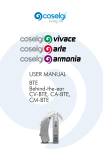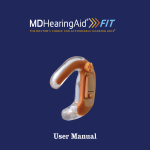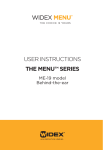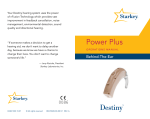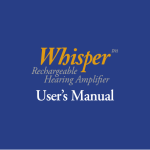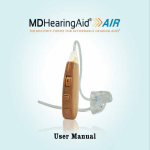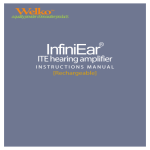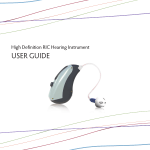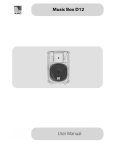Download Digital / Programmable User Manual
Transcript
Prairie Labs Inc. Instruction Manual: From your hearing healthcare professional and Prairie Labs Inc. 1 This manual contains important user information for the following Prairie Labs hearing instruments. Your hearing healthcare provider can check and circle the appropriate information for your hearing instrument. Prairie Songs 1 Custom / BTE Prairie Songs 2 Custom / BTE Prairie Songs 4 Custom / BTE Liberty Open Fit / BTE Freedom 4 Open Fit Monarch Open Fit Revolution Receiver-in-the-Canal Open Fit Other _________________________ Thank you for choosing Prairie Labs for your hearing needs. 2 Dear Hearing Instrument User: You are now the owner of a new fully digital Prairie Labs hearing instrument that has been especially designed for you using state of the art circuitry with the highest quality materials and workmanship. In order to maximize the useful life of your hearing instrument we have compiled some helpful hints that, if followed, will help you to get the most out of your hearing instrument and batteries. Please Remember: It takes time and patience to get comfortable with your new hearing instrument. Even if you are an experienced user of hearing instruments, you’re surrounding may, at first, sound noisy or unnatural. Using your hearing instrument on a regular basis will help you get the greatest benefit from your new fitting. Learn to ‘focus’ on the people or sounds you want to hear. Do not hesitate to consult your hearing healthcare professional for advice. We wish you good hearing! 3 Table of contents Knowing Your Hearing Aid………..…... 3 Left & Right Instruments…………...…...4 Proper Placement………………....…4,5,6 Removing Instruments………….….........7 Volume Control…………………...……..7 Push Button/Multi Memory………...…...8 Directionality……………...……..………8 Telephone Use…………………….……..9 Battery Information…………………..9,10 Cleaning Your Hearing Instrument…11,12 Hearing Instrument Care & Protection……13,14 Important Notice for Prospective Hearing Aid Users………………..…..…15,16 Notice for Hearing Healthcare Providers….….17 Extended Storage……………………………..18 Children with Hearing Loss…………………..18 Troubleshooting Guide……………………19,20 Warranty Information…………………………21 Service & Repair Information………….……..21 Owner Information……………………...…22,23 Key Word Index………………...……………24 4 Knowing your Hearing Aid 1. Microphone 2. Battery Door 3. Push Button 4. Volume Control 5. Sound Tube 6. Ear Bud 7. Ear Hook 8. 2nd Microphone 9. Canal 10. Retention Guard Note: Features may vary depending on model. 5 Proper Placement On/In the Ear If you are wearing hearing instruments on both ears, it is important to use the correct devise in each ear. The sound tubes or molds are marked with ‘red’ lettering for the right ear, and ‘blue’ lettering for the left ear. Your hearing instrument should fit comfortably and easily in or over the top of your ears. Your hearing healthcare provider will provide instruction on proper insertion and removal. Use the following instructions if you own an Open Fit hearing instrument with a flex tube (Sound Tube) and ear bud. See pictures on top of next page. 1. Place the hearing instrument over the top of your ear. 2. Hold the sound tube where it attaches to the ear bud (where it bends) and gently push the ear bud into your canal until it is just inside your ear canal (the tube should be flush against your head). 3. Place the retention guard of the sound tube into the bowl of your concha. To turn your hearing instrument “on”, you simply need to close the battery door after inserting a battery. To turn your hearing instrument “off”, open the battery door completely. 6 Step 1 Step 2 7 Step 3 Proper Placement On/In the Ear (cont.) Use the following instructions if you own a custom hearing instrument or a behind the ear hearing instrument with a custom mold. See pictures on previous page. 1. 2. 3. 4. With the hearing instrument in the off position grasp your custom hearing instrument or mold with your thumb and index finger. Carefully insert the canal portion of the hearing instrument or mold into the ear. Gently twist and push the hearing instrument or mold until properly seated. For a behind the ear hearing instrument you can now place the instrument behind your ear. Once your hearing instrument is properly seated, you can easily turn it ‘On’ or ‘Off’ by turning the volume control or closing the battery door. 8 Removing the Hearing Instrument To remove the hearing instrument from your ear, simply grasp the instrument, mold or sound tube with your thumb and index finger and gently pull them outward. Please be careful not to remove the custom instrument by pulling on the battery door or volume control as this could easily cause damage that would require repair. After removing hearing instruments from your ears, make sure to open the battery door. This will turn the instrument off and conserve battery power. Consult your hearing healthcare provider if you have difficulty removing the hearing instrument. Volume Control If your hearing instrument is equipped with a volume control, you will be able to adjust the volume of your hearing instrument. When wearing these instruments, you can increase the volume by turning the volume control wheel up, and reduce volume by turning it down. By turning the volume control all the way down, you will feel a click; this is how you can turn your hearing instrument off and on. Be careful not to force the volume control beyond where it stops, this could damage your hearing instrument. 9 Push Button for Multi-Memory These hearing instruments can have up to four different memories for different environmental settings and listening situations. The selection of memories can be changed by your hearing healthcare provider. You can easily move between memories with the push of a button. Each time you switch memories, your hearing instrument will alert you of which program you have switched to with tones equal to the program number. The push button control is located on the top of your hearing instrument. You can always return to memory one by turning your instrument off and then on again. Your hearing healthcare provider will discuss these options with you and program the memories accordingly. Directionality If your hearing instrument is equipped with directionality, you will be able to use the push button to switch between this option and the single microphone option. This option actually allows your hearing aid specialist to program your instrument to one of 3 different directional patterns suiting your needs. Please talk to your hearing healthcare professional about this feature and when it should be used. 10 Telephone Use Your hearing instruments allow you to use a phone as you normally would, holding the phone up to your ear. If you experience discomfort from the any part of the hearing instrument pressing in your ear canal, you may want to contact your hearing healthcare professional. Some hearing instruments can be equipped with a t-coil for enhanced sound quality when using the phone, please ask your hearing healthcare provider if your hearing instrument has this feature. They will be able to explain how this will work. Battery Information Important: Hearing instrument batteries should be kept out of reach of small children and pets. Small batteries can be harmful if swallowed. In case of ingestion, contact your physician or call the National Button Battery Hotline at 202-625-3333. Your hearing healthcare provider can activate a low battery warning function in your hearing instruments. The low battery detection system continuously monitors battery life. You will hear warning beeps when the battery becomes low. 11 Battery Information (cont.) To replace your hearing instrument battery follows these steps: 1. 2. 3. Carefully lift the notch of the battery door and swing it open. Remove the battery. Remove the colored tab on the new battery, slide in the battery with the ‘+’ facing the “+” on the battery door. Gently swing the door into the closed position. This should be done slowly to ensure that there isn’t any damage done to the instrument. You should never have to force it closed, if there is resistance, check to make sure the battery was inserted correctly. Batteries have a limited life span even if they have never been used. The life of your hearing instruments’ batteries will vary depending on length of daily use, listening environments, and how your hearing instruments are programmed. When the hearing instrument batteries go dead, remove them immediately and replace them with new batteries. Purchase batteries from a reputable source, such as your hearing healthcare professional. When you’re hearing instruments are not in use, open the battery compartment to prevent excessive battery drain. 12 Cleaning you Hearing Instruments The following instructions will assist in extending the life of your hearing instrument. You should inspect your hearing instruments daily and clean them periodically to control wax build up. To clean the exterior of the instrument, very gently wipe the surface with a soft dry cloth. Do not allow water or liquid to enter any openings on the instrument. You can also use the soft bristle brush provided to gently clean the exterior of your hearing instrument. The sound tube on your open fit instrument and behind-the-ear hearing instruments delivers the amplified sound from the hearing instrument into the ear. It is important that these components fit properly in your ear. If the case, sound tube, ear bud or custom mold irritates your ear in any way, contact your hearing healthcare provider. Please don’t attempt to modify the shape or length of the sound tube or mold yourself. The tube and bud should be cleaned regularly according to the instructions on the following pages. Ear wax can easily be removed by your physician or in some cases your hearing healthcare provider. You should not use cotton swabs to clean your ears, due to the risk of pushing the wax deeper into the ear canal. 13 Cleaning the Sound Tube and Ear Bud On your open fit instruments (excludes receiver in canal open fit), you can remove the sound tube from the hearing instrument by gently twisting while pulling it straight away from the instrument. Use the cleaning rod (provided in the storage case) to clean the sound tube and ear bud. Gently push the cleaning rod through the sound tube, inserting at the opening where the tube attaches to the body of the instrument and push out through the ear bud. Use a damp cloth to clean the exterior of the sound tube and ear bud. Never rinse or submerge any parts of your hearing instrument in water. Moisture will prevent sound from coming through the tube and may be harmful to the instrument’s electronics. Re-attach the sound tube onto the body of the instrument by holding the sound tube in one hand and the hearing instrument in the other hand. Line up the sound tube and the connecting end of the instrument; push the sound tube straight onto the instrument body. If the sound tube or the ear bud becomes stiff, brittle, kinked or damaged, they will need to be changed. See your hearing healthcare professional to change the ear bud. This is to prevent the ear bud from detaching from the sound tube during insertion into the ear. If your hearing healthcare provider instructs you to change the ear buds yourself, make sure they are securely fastened to the sound tube before inserting them in your ear. Failure to change the ear bud in accordance with the instructions could result in injury. 14 Hearing Instrument Care and Protection The most common causes of hearing instrument repair are wax and moisture. If you are encountering recurrent repairs, please discuss the various wax/moisture prevention systems and accessories with your hearing healthcare provider. • • • Always keep your hearing instrument as dry as possible. If the hearing instrument gets wet, never attempt to dry it by using a hair dryer, microwave or conventional oven. Excessive heat generated by these devices could permanently and irreversibly damage your hearing instrument. If you live in a humid climate or perspire heavily, we recommend the use of a hearing instrument drying kit (be sure and remove batteries first). Your hearing healthcare provider can provide you with further assistance in this matter. Safely store hearing instruments when not in use. Keep them out of the reach of small children and pets. When you are not using your hearing instrument for an extended period of time, remove the battery to prevent damage due to battery leakage. 15 Hearing Instrument Care and Protection (cont.) • • • • • • Remove your hearing instruments for MRI, CAT scans or other electromagnetic procedures at your dentist or medical facility. It is best to keep them outside the room of the X-ray equipment. Remove your hearing instruments when using a hair dryer, hair spray or skin creams at home or when at the beauty salon, spa or barber. Keep hearing instruments out of the bathroom when taking a bath or shower. Don’t use soap, detergents or chemicals to clean your hearing instruments. Use a clean dry cloth, tissue or small soft brush to gently wipe or brush your hearing instrument clean. Don’t use any sharp objects, such as a pin, to clear your hearing instruments or remove wax. Please don’t attempt to perform any repairs on your hearing instrument. Doing so could cause further damage and will void the warranty. Never wear the instruments while taking a bath, shower, spa treatment or while swimming. 16 Important Notice for Prospective Hearing Aid Users Good health practice requires that a person with a hearing loss have a medical evaluation by a licensed physician, who specializes in diseases of the ear, before purchasing a hearing instrument. Licensed physicians who specialize in the diseases of the ear are often referred to as Otologists, Otolaryngologists (ear, nose and throat – ENT) or Otorhinolaryngologists. The purpose of a medical evaluation is to assure that all medically treatable conditions that may affect hearing are identified and treated before the hearing instrument is purchased. Following the medical evaluation, the physician will give you a written statement that your hearing loss has been medically evaluated and that you may be considered a candidate for a hearing instrument. The physician can refer you to an audiologist or a hearing instrument specialist for a hearing instrument evaluation. This will enable the hearing specialist or audiologist to select and fit a hearing instrument to your individual needs. Federal law restricts the sale of hearing instruments to those individuals who have obtained a medical evaluation from a licensed physician. 17 Important Notice for Prospective Hearing Aid Users (cont.) Federal law allows a fully informed adult to sign a waiver statement declining the medical evaluation for religious or personal beliefs that preclude consultation with a physician. The exercise of such a waiver is not in your best interest, and its use is strongly discouraged. If you have reservations about your ability to adapt to amplification, you should inquire about the availability of a trial-rental or purchase option program. Many hearing instrument dispensers now offer programs that permit you to wear a hearing instrument for a period of time for a nominal fee, after which you may decide if you want to purchase the hearing instrument. *A hearing instrument will not restore normal hearing and will not prevent or improve a hearing impairment resulting from organic conditions. *The use of a hearing instrument is only part of hearing rehabilitation and may need to be supplemented by auditory training and instructions in lip reading. *Consistent use of the hearing instrument is recommended. In most cases, infrequent use does not permit you to attain full benefit from it. 18 Notice for hearing healthcare providers Hearing healthcare providers should advise a prospective hearing instrument user to consult promptly with a licensed physician (preferably an ear specialist) before dispensing a hearing instrument if the hearing healthcare provider determines through inquiry, actual observation, or review of any other available information concerning the prospective user, that the prospective user has any of the following conditions: • Visible congenital or traumatic deformity of the ear. • History of active drainage from the ear within the previous 90 days. • History of sudden or rapidly progressive hearing loss within previous 90 days. • Acute or chronic dizziness. • Unilateral hearing loss of sudden or recent onset within the previous 90 days. • Audiometric air-bone gap greater than or equal to 15 decibels at 500 Hertz(Hz), 1000 Hz, and 2000 Hz. • Visible evidence of significant cerumen (wax) accumulation or a foreign body in the ear canal. • Pain or discomfort in the ear. Special care should be exercised in selecting and fitting a hearing instrument which has a maximum sound pressure level in excess of 132 dB (decibels) because there may be a risk of damaging the remaining hearing of the hearing instrument user. 19 Extended Storage If it is necessary to store your hearing instruments for an extended amount of time, follow the steps below for proper storage. 1. 2. 3. Remove the batteries Clean the instrument according to instructions on page 11. Place the instruments in a cool, dry place. Either their original container or a hearing instrument dehumidifier is recommended. Children with Hearing Loss In addition to seeing a physician for a medical evaluation, a child with a hearing loss should be directed to an audiologist for evaluation and rehabilitation since hearing loss may cause problems in language development and the education and social growth of a child. An audiologist is qualified by training and experience to assist in the evaluation and rehabilitation of a child with hearing loss. 20 Troubleshooting Guide Weak/No Sound: • Ensure that hearing instruments are turned on. • Replace the battery. • Ensure that there is no wax or debris in the sound tube. • Changes in your hearing loss can affect how you hear with a hearing instrument. Contact your hearing healthcare provider if you suspect any change in your hearing status. Sound is Distorted or Unclear: • Replace the battery. • If you are near an electromagnetic field (i.e. near a computer screen or fluorescent lights), step away to see if the static clears. • Ensure that there is no wax or debris in the sound tube. • Hearing instruments may have a poor battery contact or may not be programmed properly. Contact your hearing healthcare provider. 21 Troubleshooting Guide (cont.) Whistling/Feedback: • Ensure that your hearing instruments are properly placed in and/or up behind the ear and the ear bud/mold is put into the ear canal. • Excessive earwax, improperly sized instruments, and large vents can cause whistling. Contact your hearing healthcare provider. Intermittent: • Replace the battery. • Ensure that there is no wax or debris in the sound tube. • Hearing instruments may have a poor battery contact or may not be programmed properly. Contact your hearing healthcare provider. 22 Warranty Information Please ask your hearing healthcare provider regarding your specific warranty information for your hearing instruments. Manufacture warranty covers any defect in material or workmanship. It doesn’t cover problems with accessories such as cords or batteries. We will, at our option, repair or replace the instruments or any defective part, at our expense, within the limits of the warranty. This warranty shall be limited to the warranty option your hearing healthcare provider purchased, which started from the date of purchase. Only the original manufacture is authorized to perform any warranty work. All warranty work performed by the manufacturer will be done within a reasonable period of time. If warranty work is performed and there appears to be a defect, malfunction, or failure to conform to the warranty, the obligations will be met if brought to our attention within the allotted warranty period. The warranty will become invalid if the hearing instruments have been tampered with or altered in any way, or if the serial number has been altered, effaced or removed. 23 Owner Information Every Prairie Labs hearing instrument comes with a model & serial number. Please keep this information in a safe place. (see below). 24 Owner Information Model: __________________________________________________________ Serial Numbers: Left: _____________________________________________________ Right: ____________________________________________________ Purchase Date: ____________________________________________________ Battery Size: ______________________________________________________ Memory Set Up: Memory 1:________________________________________________ Memory 2:________________________________________________ Memory 3:________________________________________________ Memory 4:________________________________________________ Warranty Expires: _________________________________________________ The following U.S. Patents pertain to the Revolution Receiver-in-the-Canal Open Fit hearing instrument: 5,606,621; 7,139,404; 7,110,562; 7,016,512; D501,255; D529,612 25 Key Word Index Adjusting to your Hearing Instrument…..1 Alert Tones…………………………….8,9 Battery Information………7,9,10,13,19-20 Care & Cleaning………………….....11-14 Children with Hearing Loss…………….18 Directionality……………...……..………8 Ear Bud………………………3,4,11,12,20 Ear Wax/Cerumen……..11,13,14,17,19,20 Left/Right Instruments……….………….4 Mold/Shell…………………….4,6,7,11,20 National Battery Hotline………....………9 Notice for Users/Providers………….....…..15-17 Owner Information……………………...…22,23 On/Off Functions………………………….4, 6-8 Proper Placement/Removal……………4-7,11,20 Push Button/Multi Memory…………………..3,8 Service & Repair Information………….……..21 Sound Tube…………………………..……3-7,19 Telephone Use…………………..………………9 Troubleshooting ……………………...……19,20 Volume Control……………………....……….6,7 Warranty Information……………………….…21 26 (Back Cover) HEARING HEALTHCARE PROVIDER MADE IN THE U.S.A MANUFACTURED BY PRAIRIE LABS INC. Version 1.1 January 1, 2010 27



























